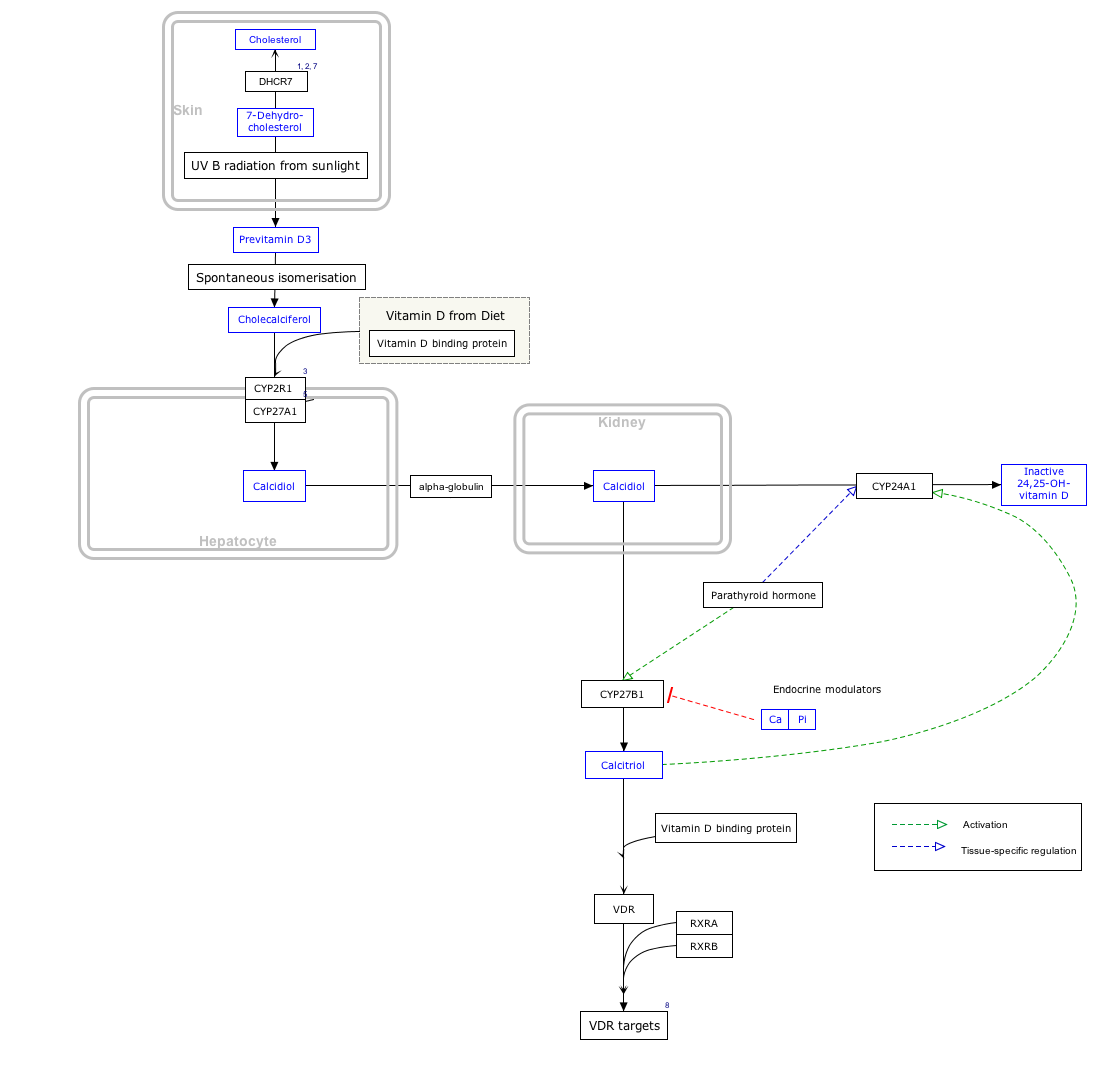Cholecalciferol/ja: Difference between revisions
Created page with "研究者らは、この化合物は前世代の抗凝固殺鼠剤(ワルファリンやコンジェナー)やブロメタリンよりも非標的種に対する毒性が低く、リレー中毒(毒殺された動物を食べることによる中毒)は記録されていないと報告している。とはいえ、殺鼠剤中のコレカルシフェロール..." |
|||
| (21 intermediate revisions by the same user not shown) | |||
| Line 90: | Line 90: | ||
コレカルシフェロールは、[[Ultraviolet/ja#Subtypes|UVB光]]曝露後の皮膚で作られる。肝臓で[[calcifediol/ja|カルシフェジオール]](25-ヒドロキシビタミンD)に変換され、腎臓で[[calcitriol/ja|カルシトリオール]](1,25-ジヒドロキシビタミンD)に変換される。一部の[[fish/ja|魚]]、牛レバー、卵、チーズなどの食品に含まれる。植物、牛乳、フルーツジュース、ヨーグルト、マーガリンにも、アメリカを含む一部の国ではコレカルシフェロールが添加されていることがある。 | コレカルシフェロールは、[[Ultraviolet/ja#Subtypes|UVB光]]曝露後の皮膚で作られる。肝臓で[[calcifediol/ja|カルシフェジオール]](25-ヒドロキシビタミンD)に変換され、腎臓で[[calcitriol/ja|カルシトリオール]](1,25-ジヒドロキシビタミンD)に変換される。一部の[[fish/ja|魚]]、牛レバー、卵、チーズなどの食品に含まれる。植物、牛乳、フルーツジュース、ヨーグルト、マーガリンにも、アメリカを含む一部の国ではコレカルシフェロールが添加されていることがある。 | ||
<!-- Use as a medication --> | <!-- Use as a medication --> | ||
コレカルシフェロールは、[[vitamin D deficiency/ja|ビタミンD欠乏症]]を予防するための経口栄養補助食品として、または[[rickets/ja|くる病]]などの関連疾患を治療するための医薬品として服用することができる。また、[[familial hypophosphatemia/ja|家族性低リン血症]]、[[low blood calcium/ja|低血中カルシウム]]を引き起こしている[[hypoparathyroidism/ja|副甲状腺機能低下症]]、[[Fanconi syndrome/ja|ファンコニー症候群]]にも用いられる。ビタミンDサプリメントは、重度の[[kidney disease/ja|腎臓病]]の人には効果がないことがある。ヒトでの過剰摂取は、嘔吐、便秘、衰弱、錯乱を引き起こすことがある。その他のリスクとしては[[kidney stones/ja|腎臓結石]]がある。一般に、[[high blood calcium/ja|高血中カルシウム]]が起こる前に、1日あたり40,000{{nbsp}}[[:en:International unit|IU]](1,000{{nbsp}}μg)を超える用量が必要とされる。通常量である1日800~2000IUは、[[pregnancy/ja|妊娠中]]でも安全である。 | |||
<!-- History and culture --> | <!-- History and culture --> | ||
コレカルシフェロールは1936年に初めて記載された。[[WHO Model List of Essential Medicines/ja|世界保健機関の必須医薬品リスト]]に掲載されている。2021年には、10{{nbsp}}万以上の処方で、米国で65番目によく処方される医薬品であった。コレカルシフェロールは[[generic medication/ja|ジェネリック医薬品]]および[[over the counter/ja|市販薬]]として入手可能である。 | |||
==医薬用途{{Anchor|Medical uses}}== | |||
==Medical uses== | コレカルシフェロールは、[[vitamin D2/ja|ビタミンD<sub>2</sub>]]とは異なり、細菌やウイルスから身体を守る[[interferon type I/ja|インターフェロンI型]]シグナル伝達システムを刺激するようである。 | ||
===ビタミンD欠乏症=== | |||
=== | {{Main/ja|Vitamin D deficiency/ja}} | ||
{{Main|Vitamin D deficiency}} | コレカルシフェロールは、皮膚で自然に合成されるビタミンDの一種で、プロホルモンとして機能し、[[calcitriol/ja|カルシトリオール]]に変換される。これは、カルシウム濃度を維持し、骨の健康と発育を促進するために重要である。医薬品として、コレカルシフェロールはビタミンD欠乏症の予防や治療のために栄養補助食品として摂取されることがある。1グラムは40,000,000(40x10<sup>6</sup>)[[:en:International unit|IU]]であり、等価的に1IUは0.025 μgまたは25ngである。ビタミンD(D<sub>2</sub>である[[ergocalciferol/ja|エルゴカルシフェロール]]および/またはD<sub>3</sub>であるコレカルシフェロール)の食事摂取基準値が設定されており、推奨値は国によって異なる: | ||
*米国では 米国では、1歳から70歳までのすべての人(男性、女性、妊娠中・授乳中の女性)に対して、15 μg/日(600IU/日)である。70歳以上では、20 μg/日(800IU/日)が推奨されている。 | |||
* | *EUでは EUでは、1歳以上のすべての人に15 μg/日(600IU/日)、7~11ヵ月の乳児には10 μg/日(400IU/日)を推奨している。 | ||
* | *英国では、「安全摂取量」(SI)は8. 1歳未満の乳児(母乳のみで育てられた乳児を含む)は5~10 μg/日(30~400IU/日)、1~4歳未満の小児は10 μg/日(400IU/日)、4歳以上のその他の集団(妊娠中・授乳中の女性を含む)は10 μg/日(400IU/日)の基準栄養摂取量(RNI)である。 | ||
* | |||
ビタミンD濃度が低いのは、北半球の緯度に住んでいる人や、家にいる人、体が弱い人、高齢者、肥満の人、肌が黒い人、肌の大部分を覆う服を着ている人など、日光浴を定期的にしていない人によく見られる。このような人々にはサプリメントが推奨される。 | |||
2010年の[[:en:Institute of Medicine|Institute of Medicine]]では、ビタミンDの最大摂取量は4,000 IU/日を推奨し、最も副作用が少ない用量は1日40,000 IUを12週間以上摂取することであり、1日10,000 IU以上を7年以上摂取して毒性を示した症例は1例であるとしている。この毒性症例は、他の研究者がビタミンD摂取推奨の際に考慮すべき症例として異論を唱えている状況下で発生したものである。重度のビタミンD欠乏症の患者には[[loading dose/ja|負荷量]]による治療が必要である。その量は実際の血清25-ヒドロキシビタミンD値と体重から計算できる。 | |||
コレカルシフェロール(D<sub>3</sub>)と[[ergocalciferol/ja|エルゴカルシフェロール]](D<sub>2</sub>)の相対的な有効性については相反する報告があり、D<sub>2</sub>の有効性が低いとする研究もあれば、差がないとする研究もある。2つの型の吸収、結合、不活性化には違いがあり、血中濃度を上げるには通常コレカルシフェロールに有利な証拠があるが、さらなる研究が必要である。 | |||
[[rickets/ja|くる病]]におけるコレカルシフェロール療法のあまり一般的でない使用法は、1回の大量投与であり、''ストス''療法と呼ばれている。治療は、経口または[[intramuscular injection/ja|筋肉内注射]]で、300,000IU(7,500 μg)~500,000IU(12,500 μg=12.5 mg)を単回投与するか、場合によっては2~4回に分けて投与する。このような大量投与の安全性については懸念がある。 | |||
循環ビタミンD濃度が低いことは、男性の総[[testosterone/ja|テストステロン]]濃度の低下と関連している。ビタミンDの補充は[[total testosterone concentration/ja|総テストステロン濃度]]を改善する可能性があるが、さらなる研究が必要である。 | |||
===その他の疾患=== | |||
=== | 2007年のメタアナリシスでは、ビタミンD<sub>3</sub>を1日あたり1000~2000IU摂取することで、大腸がんの発生率を最小限のリスクで減少させることができると結論づけている。また、2008年にCancer Research誌に発表された研究では、1日1000IUのコレカルシフェロールを摂取させた新しい欧米食と同様の栄養組成のマウスに、ビタミンD<sub>3</sub>を(カルシウムとともに)添加したところ、大腸がんの発生が抑制されたことが示されている。ヒトでは、1日400IUのコレカルシフェロールサプリメントでは、大腸癌のリスクに対する影響は見られなかった。 | ||
コレカルシフェロールのいかなる効果も非常に小さいため、サプリメントはがんの予防には推奨されない。血中コレカルシフェロール濃度が低いことと、さまざまながん、[[multiple sclerosis/ja|多発性硬化症]]、[[tuberculosis/ja|結核]]、心臓病、糖尿病の罹患率が高いこととの間には相関関係があるが、サプリメントで補うことは有益ではないというのがコンセンサスである。結核は低レベルをもたらすと考えられている。しかし、この2つがどのように関連しているかは完全には明らかになっていない。 | |||
==生化学{{Anchor|Biochemistry}}== | |||
==Biochemistry== | === 構造 === | ||
=== | コレカルシフェロールは[[vitamin D/ja|ビタミンD]]の5つの形態のうちの1つである。コレカルシフェロールは[[secosteroid/ja|セコステロイド]]、すなわち環が1つ開いたステロイド分子である。 | ||
===作用機序=== | |||
コレカルシフェロール自体は不活性である。それは2つの[[hydroxylation/ja|水酸化]]によって活性型に変換される:1つ目は肝臓で、[[CYP2R1/ja|CYP2R1]]または[[CYP27A1/ja|CYP27A1]]によって、25-ヒドロキシコレカルシフェロール([[calcifediol/ja|カルシフェジオール]]、25-OHビタミンD<sub>3</sub>)を形成する。第二の水酸化は主に腎臓で[[CYP27B1/ja|CYP27B1]]の作用により起こり、25-OHビタミンD<sub>3</sub>を1,25-ジヒドロキシコレカルシフェロール([[calcitriol/ja|カルシトリオール]]、1,25-(OH)<sub>2</sub>ビタミンD<sub>3</sub>)に変換する。これらの代謝産物はすべて、血中では[[vitamin D-binding protein/ja|ビタミンD結合タンパク質]]と結合している。カルシトリオールの作用は[[ビタミンD受容体]]によって媒介される。[[vitamin D receptor/ja|ビタミンD受容体]]は[[nuclear receptor/ja|核内受容体]]であり、数百のタンパク質の合成を制御し、体内のほぼすべての細胞に存在する。 | |||
===生合成=== | |||
右下のアイコンをクリックして開く。 | |||
{{VitaminDSynthesis_WP1531|highlight=Cholecalciferol}} | {{VitaminDSynthesis_WP1531|highlight=Cholecalciferol}} | ||
[[7-Dehydrocholesterol/ja|7-デヒドロコレステロール]]はコレカルシフェロールの前駆体である。皮膚の表皮層内で、7-デヒドロコレステロールは290~315 nmの[[wavelengths/ja|波長]]の[[Ultraviolet light/ja#Subtypes|UVB光]]によって[[electrocyclic reaction/ja|電気環式反応]]を起こし、295~300 nmの間に合成のピークが生じる。その結果、[[Conrotatory and disrotatory/ja|逆回転]]経路を通してビタミン前駆体のB環が開き、[[previtamin D3/ja|プレビタミンD<sub>3</sub>]](プレコレカルシフェロール)が作られる。紫外線に依存しないプロセスで、プレコレカルシフェロールは次に[1,7]アンタラフェイシャル[[Sigmatropic reaction/ja|シグマトロピック]]転位を受け、そこで最終的に異性化してビタミンD<sub>3</sub>を形成する。 | |||
[[7-Dehydrocholesterol]] | |||
活性のあるUVB波長は太陽光に含まれており、太陽の強さにもよるが、皮膚を適度に露出させることで十分な量のコレカルシフェロールを生成することができる。時間帯、季節、緯度、標高は太陽の強さに影響し、汚染、雲、ガラスはすべてUVBの照射量を減少させる。顔、腕、脚を週に2回、平均5~30分浴びれば十分かもしれないが、肌の色が黒く、日差しが弱ければ弱いほど、何分も浴びる必要がある。紫外線を浴びることによってビタミンDを過剰摂取することは不可能である。 | |||
コレカルシフェロールは、主に[[Ultraviolet light/ja#Subtypes|UVA]]スペクトルの紫外線を発生させる[[:en:tanning bed|日焼けベッド]]のUVランプから放出される光によって皮膚で生成される可能性があるが、通常、UVBとして全紫外線放出の4%~10%を発生させる。日焼けサロンを頻繁に利用する人の血中濃度は高い。 | |||
コレカルシフェロールとビタミンDのすべての形態が''[[vitamins/ja|ビタミン]]''の定義に含まれるかどうかは議論の余地がある。なぜなら、ビタミンの定義には、その物質が体内で合成されず、摂取しなければならないことが含まれているからだ。コレカルシフェロールは、UVB線に曝されたときに体内で合成される。 | |||
ビタミンD<sub>3</sub>の合成と活性化の3つのステップは、以下のように調節されている: | |||
* コレカルシフェロールは、紫外線B(UVB)の作用により、皮膚で7-デヒドロコレステロールから合成される。コレカルシフェロールは、緯度、季節、雲量、高度によって決まる日光のUVBの強さと、皮膚の年齢と色素沈着の度合いによって、数分後に平衡に達する。 | |||
* | * 肝臓[[hepatocyte/ja|肝細胞]]の小胞体における[[CYP2R1/ja|25-水酸化酵素]]によるコレカルシフェロールのカルシフェジオール(25-ヒドロキシコレカルシフェロール)への水酸化は、調節が緩く、この分子の血中濃度は、摂取したビタミンD<sub>2</sub>またはD<sub>3</sub>と組み合わせた皮膚で生成されたコレカルシフェロールの量を大きく反映する。 | ||
* | * 腎臓における[[25-Hydroxyvitamin D3 1-alpha-hydroxylase/ja|1-α-ヒドロキシラーゼ]]によるカルシフェジオールからカルシトリオールへの水酸化は厳密に制御されている:[[parathyroid hormone/ja|副甲状腺ホルモン]]によって刺激され、活性循環ホルモン[[calcitriol/ja|カルシトリオール]](1,25-ジヒドロキシビタミンD<sub>3</sub>)の産生における主要な制御点として機能する。 | ||
* | |||
==工業生産{{Anchor|Industrial production}}== | |||
==Industrial production== | コレカルシフェロールは、[[multivitamin/ja|ビタミンサプリメント]]や[[food fortification/ja|食品を強化する]]ために工業的に生産されている。[[pharmaceutical drug/ja|薬物]]としてはコレカルシフェロール([[:en:United States Adopted Name|USAN]])またはコレカルシフェロール([[:en:International Nonproprietary Name|INN]]、[[:en:British Approved Name|BAN]])と呼ばれる。羊の[[wool/ja|羊毛]]に含まれる[[lanolin/ja|ラノリン]]から抽出した[[7-dehydrocholesterol/ja|7-デヒドロコレステロール]]に[[ultraviolet/ja|紫外線]]を照射することで生成される。コレステロールは羊毛を刈った後の洗浄で得られる羊毛脂や羊毛ワックスアルコールから抽出される。コレステロールは4段階の工程を経て、動物の皮膚で生成されるのと同じ化合物である7-デヒドロコレステロールになる。この7-デヒドロコレステロールに紫外線を照射する。照射中にいくつかの不要な[[isomers/ja|異性体]]が生成されるが、様々な技術によって除去され、室温程度で溶ける樹脂が残り、通常1グラムあたり25,000,000~30,000,000国際単位の効力がある。 | ||
[[File:Cholecalciferol synth.png|500px]] | [[File:Cholecalciferol synth.png|500px]] | ||
コレカルシフェロールは、[[lichen/ja|地衣類]]からビタミンサプリメント用に工業生産もされており、菜食主義者にも適している。 | |||
==安定性== | |||
コレカルシフェロールは[[ultraviolet/ja|UV放射]]に非常に敏感で、速やかに、しかし可逆的に分解して超ステロールを形成し、さらに不可逆的に[[ergosterol/ja|エルゴステロール]]に変換する。 | |||
==殺虫剤{{Anchor|Pesticide}}== | |||
==Pesticide== | げっ歯類は他の種よりも高用量にやや弱く、コレカルシフェロールはこれらの害虫駆除のために毒餌に使用されてきた。 | ||
高用量のコレカルシフェロールの機序は、「[[hypercalcemia/ja|高カルシウム血症]]を引き起こし、その結果、軟部組織の全身石灰化が起こり、[[kidney failure/ja|腎不全]]、[[cardiac/ja|心臓]]異常、[[hypertension/ja|高血圧]]、中枢神経系抑制、および消化器系不調を引き起こす。徴候は一般に摂取後18~36時間以内に発現し、抑うつ、[[loss of appetite/ja|食欲不振]]、[[polyuria/ja|多尿]]、[[polydipsia/ja|多飲]]を含むことがある。」 高用量のコレカルシフェロールは[[adipose/ja|脂肪]]組織に急速に蓄積する傾向があるが、放出は遅いため、高用量のエサが投入されてから数日間は死亡時刻を遅らせる傾向がある。 | |||
ニュージーランドでは、[[:en:Common brushtail possum|ポッサム]]が重要な有害動物となっている。ポッサムの防除には、致死量のベイト剤の有効成分としてコレカルシフェロールが使用されている。致死量の[[中央値|LD<sub>50</sub>]]は16.8 mg/kgであるが、ベイト剤に炭酸カルシウムを加えた場合は9.8 mg/kgである。腎臓と心臓が標的臓器である。ウサギではLD<sub>50</sub>が4.4 mg/kgと報告されており、15 mg/kgを超える量を摂取したウサギのほとんどに致死性がある。毒性はコレカルシフェロールの投与量の広い範囲で報告されており、犬ではLD<sub>50</sub>が88 mg/kgと高く、LD<sub>Lo</sub>が2 mg/kgと低いことが報告されている。 | |||
研究者らは、この化合物は前世代の抗凝固殺鼠剤([[Warfarin/ja|ワルファリン]]や[[Congener (chemistry)/ja|コンジェナー]])や[[Bromethalin/ja|ブロメタリン]]よりも非標的種に対する毒性が低く、[[Relay toxicity/ja|リレー中毒]](毒殺された動物を食べることによる中毒)は記録されていないと報告している。とはいえ、[[rodenticide/ja|殺鼠剤]]中のコレカルシフェロールの使用は、殺鼠剤の餌や他の形態のコレカルシフェロールを直接摂取した場合、犬や猫などの他の動物に重大な危険をもたらす可能性があると、同じ情報源は報告している。 | |||
== こちらも参照 == | == こちらも参照 == | ||
Latest revision as of 10:09, 12 April 2024
 | |
 | |
| Clinical data | |
|---|---|
| Pronunciation | /ˌkoʊləkælˈsɪfərɒl/ |
| Other names | vitamin D3, calciol, activated 7-dehydrocholesterol |
| AHFS/Drugs.com | Professional Drug Facts |
| License data | |
| Routes of administration | By mouth, intramuscular |
| ATC code | |
| Legal status | |
| Legal status | |
| Identifiers | |
| |
| CAS Number | |
| PubChem CID | |
| DrugBank | |
| ChemSpider | |
| UNII | |
| KEGG | |
| ChEBI | |
| ChEMBL | |
| Chemical and physical data | |
| Formula | C27H44O |
| Molar mass | 384.648 g·mol−1 |
| 3D model (JSmol) | |
| Melting point | 83 to 86 °C (181 to 187 °F) |
| Boiling point | 496.4 °C (925.5 °F) |
| Solubility in water | Practically insoluble in water, freely soluble in ethanol, methanol and some other organic solvents. Slightly soluble in vegetable oils. |
| |
| |
ビタミンD3としても知られるコレカルシフェロールは、日光に当たると皮膚で作られるビタミンDの一種であり、いくつかの食品に含まれており、栄養補助食品として摂取することもできる。
コレカルシフェロールは、UVB光曝露後の皮膚で作られる。肝臓でカルシフェジオール(25-ヒドロキシビタミンD)に変換され、腎臓でカルシトリオール(1,25-ジヒドロキシビタミンD)に変換される。一部の魚、牛レバー、卵、チーズなどの食品に含まれる。植物、牛乳、フルーツジュース、ヨーグルト、マーガリンにも、アメリカを含む一部の国ではコレカルシフェロールが添加されていることがある。
コレカルシフェロールは、ビタミンD欠乏症を予防するための経口栄養補助食品として、またはくる病などの関連疾患を治療するための医薬品として服用することができる。また、家族性低リン血症、低血中カルシウムを引き起こしている副甲状腺機能低下症、ファンコニー症候群にも用いられる。ビタミンDサプリメントは、重度の腎臓病の人には効果がないことがある。ヒトでの過剰摂取は、嘔吐、便秘、衰弱、錯乱を引き起こすことがある。その他のリスクとしては腎臓結石がある。一般に、高血中カルシウムが起こる前に、1日あたり40,000 IU(1,000 μg)を超える用量が必要とされる。通常量である1日800~2000IUは、妊娠中でも安全である。
コレカルシフェロールは1936年に初めて記載された。世界保健機関の必須医薬品リストに掲載されている。2021年には、10 万以上の処方で、米国で65番目によく処方される医薬品であった。コレカルシフェロールはジェネリック医薬品および市販薬として入手可能である。
医薬用途
コレカルシフェロールは、ビタミンD2とは異なり、細菌やウイルスから身体を守るインターフェロンI型シグナル伝達システムを刺激するようである。
ビタミンD欠乏症
コレカルシフェロールは、皮膚で自然に合成されるビタミンDの一種で、プロホルモンとして機能し、カルシトリオールに変換される。これは、カルシウム濃度を維持し、骨の健康と発育を促進するために重要である。医薬品として、コレカルシフェロールはビタミンD欠乏症の予防や治療のために栄養補助食品として摂取されることがある。1グラムは40,000,000(40x106)IUであり、等価的に1IUは0.025 μgまたは25ngである。ビタミンD(D2であるエルゴカルシフェロールおよび/またはD3であるコレカルシフェロール)の食事摂取基準値が設定されており、推奨値は国によって異なる:
- 米国では 米国では、1歳から70歳までのすべての人(男性、女性、妊娠中・授乳中の女性)に対して、15 μg/日(600IU/日)である。70歳以上では、20 μg/日(800IU/日)が推奨されている。
- EUでは EUでは、1歳以上のすべての人に15 μg/日(600IU/日)、7~11ヵ月の乳児には10 μg/日(400IU/日)を推奨している。
- 英国では、「安全摂取量」(SI)は8. 1歳未満の乳児(母乳のみで育てられた乳児を含む)は5~10 μg/日(30~400IU/日)、1~4歳未満の小児は10 μg/日(400IU/日)、4歳以上のその他の集団(妊娠中・授乳中の女性を含む)は10 μg/日(400IU/日)の基準栄養摂取量(RNI)である。
ビタミンD濃度が低いのは、北半球の緯度に住んでいる人や、家にいる人、体が弱い人、高齢者、肥満の人、肌が黒い人、肌の大部分を覆う服を着ている人など、日光浴を定期的にしていない人によく見られる。このような人々にはサプリメントが推奨される。
2010年のInstitute of Medicineでは、ビタミンDの最大摂取量は4,000 IU/日を推奨し、最も副作用が少ない用量は1日40,000 IUを12週間以上摂取することであり、1日10,000 IU以上を7年以上摂取して毒性を示した症例は1例であるとしている。この毒性症例は、他の研究者がビタミンD摂取推奨の際に考慮すべき症例として異論を唱えている状況下で発生したものである。重度のビタミンD欠乏症の患者には負荷量による治療が必要である。その量は実際の血清25-ヒドロキシビタミンD値と体重から計算できる。
コレカルシフェロール(D3)とエルゴカルシフェロール(D2)の相対的な有効性については相反する報告があり、D2の有効性が低いとする研究もあれば、差がないとする研究もある。2つの型の吸収、結合、不活性化には違いがあり、血中濃度を上げるには通常コレカルシフェロールに有利な証拠があるが、さらなる研究が必要である。
くる病におけるコレカルシフェロール療法のあまり一般的でない使用法は、1回の大量投与であり、ストス療法と呼ばれている。治療は、経口または筋肉内注射で、300,000IU(7,500 μg)~500,000IU(12,500 μg=12.5 mg)を単回投与するか、場合によっては2~4回に分けて投与する。このような大量投与の安全性については懸念がある。
循環ビタミンD濃度が低いことは、男性の総テストステロン濃度の低下と関連している。ビタミンDの補充は総テストステロン濃度を改善する可能性があるが、さらなる研究が必要である。
その他の疾患
2007年のメタアナリシスでは、ビタミンD3を1日あたり1000~2000IU摂取することで、大腸がんの発生率を最小限のリスクで減少させることができると結論づけている。また、2008年にCancer Research誌に発表された研究では、1日1000IUのコレカルシフェロールを摂取させた新しい欧米食と同様の栄養組成のマウスに、ビタミンD3を(カルシウムとともに)添加したところ、大腸がんの発生が抑制されたことが示されている。ヒトでは、1日400IUのコレカルシフェロールサプリメントでは、大腸癌のリスクに対する影響は見られなかった。
コレカルシフェロールのいかなる効果も非常に小さいため、サプリメントはがんの予防には推奨されない。血中コレカルシフェロール濃度が低いことと、さまざまながん、多発性硬化症、結核、心臓病、糖尿病の罹患率が高いこととの間には相関関係があるが、サプリメントで補うことは有益ではないというのがコンセンサスである。結核は低レベルをもたらすと考えられている。しかし、この2つがどのように関連しているかは完全には明らかになっていない。
生化学
構造
コレカルシフェロールはビタミンDの5つの形態のうちの1つである。コレカルシフェロールはセコステロイド、すなわち環が1つ開いたステロイド分子である。
作用機序
コレカルシフェロール自体は不活性である。それは2つの水酸化によって活性型に変換される:1つ目は肝臓で、CYP2R1またはCYP27A1によって、25-ヒドロキシコレカルシフェロール(カルシフェジオール、25-OHビタミンD3)を形成する。第二の水酸化は主に腎臓でCYP27B1の作用により起こり、25-OHビタミンD3を1,25-ジヒドロキシコレカルシフェロール(カルシトリオール、1,25-(OH)2ビタミンD3)に変換する。これらの代謝産物はすべて、血中ではビタミンD結合タンパク質と結合している。カルシトリオールの作用はビタミンD受容体によって媒介される。ビタミンD受容体は核内受容体であり、数百のタンパク質の合成を制御し、体内のほぼすべての細胞に存在する。
生合成
右下のアイコンをクリックして開く。
Click on genes, proteins and metabolites below to link to respective articles. [§ 1]
- ↑ The interactive pathway map can be edited at WikiPathways: "VitaminDSynthesis_WP1531".
7-デヒドロコレステロールはコレカルシフェロールの前駆体である。皮膚の表皮層内で、7-デヒドロコレステロールは290~315 nmの波長のUVB光によって電気環式反応を起こし、295~300 nmの間に合成のピークが生じる。その結果、逆回転経路を通してビタミン前駆体のB環が開き、プレビタミンD3(プレコレカルシフェロール)が作られる。紫外線に依存しないプロセスで、プレコレカルシフェロールは次に[1,7]アンタラフェイシャルシグマトロピック転位を受け、そこで最終的に異性化してビタミンD3を形成する。
活性のあるUVB波長は太陽光に含まれており、太陽の強さにもよるが、皮膚を適度に露出させることで十分な量のコレカルシフェロールを生成することができる。時間帯、季節、緯度、標高は太陽の強さに影響し、汚染、雲、ガラスはすべてUVBの照射量を減少させる。顔、腕、脚を週に2回、平均5~30分浴びれば十分かもしれないが、肌の色が黒く、日差しが弱ければ弱いほど、何分も浴びる必要がある。紫外線を浴びることによってビタミンDを過剰摂取することは不可能である。
コレカルシフェロールは、主にUVAスペクトルの紫外線を発生させる日焼けベッドのUVランプから放出される光によって皮膚で生成される可能性があるが、通常、UVBとして全紫外線放出の4%~10%を発生させる。日焼けサロンを頻繁に利用する人の血中濃度は高い。
コレカルシフェロールとビタミンDのすべての形態がビタミンの定義に含まれるかどうかは議論の余地がある。なぜなら、ビタミンの定義には、その物質が体内で合成されず、摂取しなければならないことが含まれているからだ。コレカルシフェロールは、UVB線に曝されたときに体内で合成される。
ビタミンD3の合成と活性化の3つのステップは、以下のように調節されている:
- コレカルシフェロールは、紫外線B(UVB)の作用により、皮膚で7-デヒドロコレステロールから合成される。コレカルシフェロールは、緯度、季節、雲量、高度によって決まる日光のUVBの強さと、皮膚の年齢と色素沈着の度合いによって、数分後に平衡に達する。
- 肝臓肝細胞の小胞体における25-水酸化酵素によるコレカルシフェロールのカルシフェジオール(25-ヒドロキシコレカルシフェロール)への水酸化は、調節が緩く、この分子の血中濃度は、摂取したビタミンD2またはD3と組み合わせた皮膚で生成されたコレカルシフェロールの量を大きく反映する。
- 腎臓における1-α-ヒドロキシラーゼによるカルシフェジオールからカルシトリオールへの水酸化は厳密に制御されている:副甲状腺ホルモンによって刺激され、活性循環ホルモンカルシトリオール(1,25-ジヒドロキシビタミンD3)の産生における主要な制御点として機能する。
工業生産
コレカルシフェロールは、ビタミンサプリメントや食品を強化するために工業的に生産されている。薬物としてはコレカルシフェロール(USAN)またはコレカルシフェロール(INN、BAN)と呼ばれる。羊の羊毛に含まれるラノリンから抽出した7-デヒドロコレステロールに紫外線を照射することで生成される。コレステロールは羊毛を刈った後の洗浄で得られる羊毛脂や羊毛ワックスアルコールから抽出される。コレステロールは4段階の工程を経て、動物の皮膚で生成されるのと同じ化合物である7-デヒドロコレステロールになる。この7-デヒドロコレステロールに紫外線を照射する。照射中にいくつかの不要な異性体が生成されるが、様々な技術によって除去され、室温程度で溶ける樹脂が残り、通常1グラムあたり25,000,000~30,000,000国際単位の効力がある。
コレカルシフェロールは、地衣類からビタミンサプリメント用に工業生産もされており、菜食主義者にも適している。
安定性
コレカルシフェロールはUV放射に非常に敏感で、速やかに、しかし可逆的に分解して超ステロールを形成し、さらに不可逆的にエルゴステロールに変換する。
殺虫剤
げっ歯類は他の種よりも高用量にやや弱く、コレカルシフェロールはこれらの害虫駆除のために毒餌に使用されてきた。
高用量のコレカルシフェロールの機序は、「高カルシウム血症を引き起こし、その結果、軟部組織の全身石灰化が起こり、腎不全、心臓異常、高血圧、中枢神経系抑制、および消化器系不調を引き起こす。徴候は一般に摂取後18~36時間以内に発現し、抑うつ、食欲不振、多尿、多飲を含むことがある。」 高用量のコレカルシフェロールは脂肪組織に急速に蓄積する傾向があるが、放出は遅いため、高用量のエサが投入されてから数日間は死亡時刻を遅らせる傾向がある。
ニュージーランドでは、ポッサムが重要な有害動物となっている。ポッサムの防除には、致死量のベイト剤の有効成分としてコレカルシフェロールが使用されている。致死量のLD50は16.8 mg/kgであるが、ベイト剤に炭酸カルシウムを加えた場合は9.8 mg/kgである。腎臓と心臓が標的臓器である。ウサギではLD50が4.4 mg/kgと報告されており、15 mg/kgを超える量を摂取したウサギのほとんどに致死性がある。毒性はコレカルシフェロールの投与量の広い範囲で報告されており、犬ではLD50が88 mg/kgと高く、LDLoが2 mg/kgと低いことが報告されている。
研究者らは、この化合物は前世代の抗凝固殺鼠剤(ワルファリンやコンジェナー)やブロメタリンよりも非標的種に対する毒性が低く、リレー中毒(毒殺された動物を食べることによる中毒)は記録されていないと報告している。とはいえ、殺鼠剤中のコレカルシフェロールの使用は、殺鼠剤の餌や他の形態のコレカルシフェロールを直接摂取した場合、犬や猫などの他の動物に重大な危険をもたらす可能性があると、同じ情報源は報告している。
こちらも参照
- Hypervitaminosis D/ja, ビタミンD中毒
- エルゴカルシフェロール, ビタミンD2
- 25-Hydroxyvitamin D 1-alpha-hydroxylase/ja, カルシフェジオールをカルシトリオールに変換する腎臓の酵素である。

